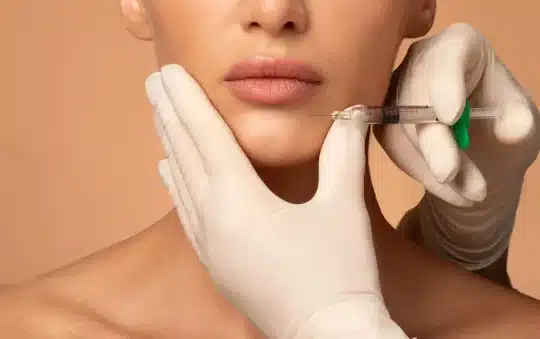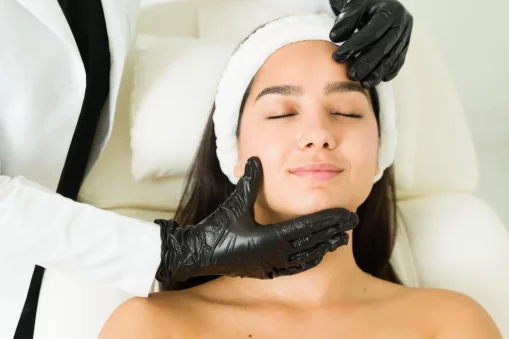No two faces are perfectly symmetrical, but for some individuals, noticeable imbalances or structural defects can affect both appearance and function. Whether due to genetics, aging, injury, or medical conditions, facial asymmetry can impact confidence and even contribute to issues like jaw misalignment or muscle imbalance.
Fortunately, dermal fillers have become a game-changer in both aesthetic and reconstructive medicine. They are a non-surgical way to restore balance, enhance contours, and address soft tissue irregularities.
Unlike traditional cosmetic filler treatments focused purely on volume and rejuvenation, using fillers for complex asymmetry and structural corrections requires a deeper understanding of facial anatomy. When done correctly, fillers can create subtle but significant improvements.
However, managing these cases isn’t always straightforward — every face is different, and the key is selecting the right filler type and place to inject it.
Understanding Facial Asymmetry and Structural Defects
Understanding the causes of facial asymmetry and structural defects is essential for medical professionals and patients seeking corrective solutions.
Causes
Facial asymmetry refers to an imbalance between the left and right sides of the face, which can be caused by various factors. While some cases are mild and purely aesthetic, others may result in significant functional impairments.
Congenital Factors
Some individuals are born with facial asymmetry due to developmental conditions that affect bone growth and soft tissue formation. These include:
- Cleft Lip and Palate – A congenital condition where incomplete formation of the upper lip and/or palate leads to structural imbalances.
- Hemifacial Microsomia – A condition where one side of the face is underdeveloped, affecting the jaw, ear, and soft tissue structures.
- Craniofacial Syndromes – Disorders such as Treacher Collins syndrome or Goldenhar syndrome can result in severe facial asymmetry from birth.
Acquired Factors
Facial asymmetry can also develop over time due to external influences
- Trauma and Injury – Accidents, fractures, or surgeries involving the face can lead to misalignment of bones or uneven soft tissue.
- Neuromuscular Disorders – Conditions such as Bell’s palsy or stroke can cause muscle weakness or paralysis on one side of the face.
- Dental and Orthodontic Issues – Severe malocclusion, missing teeth, or jaw misalignment cause problems over time.
- Surgical Interventions – Prior aesthetic or reconstructive surgeries may sometimes result in unintended asymmetries.
Age-Related Changes
Even those born with symmetrical features may develop facial asymmetry with age:
- Volume Loss – The gradual depletion of fat pads in the midface and temples can make one side appear more hollow than the other.
- Skin Laxity – A decline in collagen and elastin causes sagging, often affecting one side of the face more than the other due to habitual sleeping positions or repetitive facial expressions.
- Bone Resorption – Aging leads to gradual changes in the underlying bone structure.
Psychological and Functional Implications
Studies suggest that facial symmetry is subconsciously linked to perceptions of attractiveness and social acceptance. Individuals with noticeable asymmetries may struggle with self-esteem issues, leading to social anxiety or self-consciousness. In some cases, this can contribute to body dysmorphic disorder (BDD), where individuals fixate on perceived flaws, even if they are minor.
When asymmetry extends beyond aesthetics, it can interfere with basic functions, including:
- Speech Articulation – Imbalances in the lips or jaw can affect pronunciation and oral motor control.
- Chewing – Uneven jaw development or dental misalignment can lead to difficulties with biting and chewing food properly.
- Facial Expressions – Asymmetrical muscle function may affect natural expressions.
Dermal Fillers
Not all fillers are the same. Different types are used depending on the specific needs of each patient, ranging from subtle contour enhancements to structural support in cases of severe asymmetry. Here’s a closer look at the most common filler options:
Hyaluronic Acid (HA) Fillers
HA fillers are the most widely used due to their versatility, safety, and reversibility. Naturally found in the skin, hyaluronic acid retains moisture and adds volume where it’s needed. These fillers are ideal for:
- Restoring lost volume in areas like the cheeks, temples, and under-eye hollows.
- Refining facial contours for a smoother, more balanced appearance.
- Providing hydration benefits, improving skin texture and elasticity.
Popular HA fillers include Juvederm, Restylane, and Belotero, with different formulations designed for specific treatment areas.
Calcium Hydroxylapatite (CaHA) Fillers
CaHA fillers, such as Radiesse, contain tiny calcium-based microspheres suspended in a gel. These provide immediate volume while also stimulating collagen production for longer-lasting results. They are particularly useful for:
- Strengthening jawline definition.
- Enhancing chin projection for better facial balance.
- Addressing deep facial folds and volume loss.
Because they offer both immediate and long-term improvements, CaHA fillers are often chosen for structural corrections.
Poly-L-Lactic Acid (PLLA) Fillers
Unlike HA and CaHA fillers, PLLA fillers work gradually by stimulating the body’s natural collagen production. Sculptra, the most well-known PLLA filler, is used for:
- Treating widespread volume loss in the cheeks and temples.
- Improving skin laxity and restoring youthful firmness over time.
- Providing subtle, long-term improvements rather than instant results.
PLLA is best suited for patients looking for a natural, progressive enhancement rather than a quick fix.
Autologous Fat Transfer
For those seeking a natural and long-lasting option, fat transfer involves harvesting the patient’s own fat via liposuction, purifying it, and re-injecting it into targeted areas. This method is beneficial because:
- It uses the body’s own tissue, reducing the risk of rejection or allergic reactions.
- The results can be permanent, as a portion of the transferred fat survives long-term.
- It allows for larger volume restoration compared to synthetic fillers.
However, fat transfer is a more invasive procedure, requiring downtime and expertise to ensure even, natural-looking results.
Techniques for Correcting Asymmetry and Structural Defects
Selecting the right type of filler is crucial, nevertheless, the injection technique plays an equally important role.
The most commonly used injection techniques are:
1. Linear Threading
Best For: Deep wrinkles, nasolabial folds, marionette lines, and contouring jawlines and cheekbones.
Linear threading involves inserting the needle or cannula along the length of the wrinkle, depression, or contouring area and injecting the filler as the needle is slowly withdrawn.
Advantages:
- Ensures an even, natural-looking fill.
- Reduces the number of injection points, minimizing trauma and bruising.
- Allows for controlled sculpting of facial features.
Cons:
- Requires a skilled injector to avoid overfilling or creating unnatural ridges.
- Works best for deep folds rather than surface-level fine lines.
2. Serial Puncture
Best For: Larger areas with volume loss, such as the cheeks, temples, and pre-jowl region.
This technique involves making multiple small injections placed close together to gradually build up volume in an area. Each injection deposits a small amount of filler.
Advantages:
- Provides controlled volume restoration with minimal product wastage.
- Reduces the risk of overcorrection in a single injection site.
- Particularly useful for patients needing subtle, natural enhancements.
Cons:
- Can be slightly more time-consuming due to multiple injection points.
- Requires careful post-treatment massage to prevent unevenness.
3. Fanning
Best For: Large areas requiring smooth contouring, such as the cheeks, jawline, and temple hollows.
Fanning involves inserting the needle or cannula at a single entry point and moving it in multiple directions in a fan-like pattern to deposit filler evenly. This method allows for broad coverage with fewer injection sites, reducing trauma and discomfort.
Advantages:
- Efficiently distributes filler over a large area with fewer punctures.
- Ideal for sculpting and contouring facial features.
- Reduces the risk of bruising compared to multiple injection points.
Cons:
- Requires high-level precision to avoid excessive filler placement.
- Not ideal for fine wrinkles or delicate areas like the under-eye region.
4. Cross-Hatching
Best For: Structural support in areas with deep folds, scars, or volume loss, such as nasolabial folds and sunken cheeks.
Cross-hatching is injecting filler in a crisscross pattern, with lines of filler running in perpendicular directions. This method creates a supportive grid-like structure.
Advantages:
- Ensures uniform distribution of filler, preventing irregularities.
- Offers strong structural support for deep-set wrinkles and volume deficiencies.
- Helps reinforce weakened or scarred tissue.
Cons:
- Can lead to a denser fill, which may feel firmer in some areas.
- Requires a skilled injector to prevent overcorrection and unnatural firmness.
In Conclusion
Correcting facial asymmetry and structural defects with dermal fillers requires expertise and precision. Whether addressing congenital conditions, age-related volume loss, or trauma-related imbalances, fillers offer a highly adaptable and effective solution.
Patient selection is key, as not every asymmetry can (or should) be treated with fillers alone. Skilled practitioners must assess the underlying skeletal and soft tissue structures, understand the patient’s long-term aesthetic goals, and choose the right combination of fillers to create natural-looking results that complement overall facial proportions. Moreover, longevity and maintenance strategies must be factored in, as well.
As the field evolves, so too does the potential for dermal fillers to bridge the gap between aesthetics and reconstructive medicine.
Frequently Asked Questions (FAQs)
What are the limitations of dermal fillers in managing complex asymmetry cases?
Fillers can effectively enhance soft tissue volume and contour, but they cannot address significant skeletal discrepancies or deep structural defects. Their temporary nature also requires maintenance treatments, and in some cases, uneven distribution or migration can occur. Additionally, extreme asymmetries may require a combination of treatments, including surgery or fat grafting, for best results.
Can dermal fillers be used to correct asymmetry caused by Bell’s palsy or nerve damage?
Yes, dermal fillers can help balance facial asymmetry caused by Bell’s palsy or nerve-related muscle imbalances. They restore volume to the affected side and can subtly adjust contours for a more symmetrical appearance. However, results must be carefully planned since muscle tone and function can fluctuate, often requiring combination therapy with neuromodulators.
What are the most common complications when using dermal fillers for correcting asymmetry, and how can they be prevented?
Complications include uneven distribution, overcorrection, migration, and vascular occlusion. These risks can be minimized with precise injection techniques, the use of cannulas in high-risk areas, and thorough anatomical assessments before treatment. Hyaluronidase can reverse HA fillers in case of complications, and ultrasound is sometimes used for added safety.
How does the aging process impact the results of dermal filler treatments for asymmetry and structural defects?
Aging affects skin elasticity, collagen levels, and facial fat distribution, which can alter the results of filler treatments over time. Regular maintenance and adjustments are necessary to account for volume shifts and prevent exaggerated asymmetry. In some cases, combining fillers with skin-tightening treatments is a good approach for long-term results.
References
Occhiogrosso J, Derakhshan A, Hadlock TA, Shanley KM, Lee LN. Dermal Filler Treatment Improves Psychosocial Well-Being in Facial Paralysis Patients. Facial Plast Surg Aesthet Med. 2020 Jun 10. doi: 10.1089/fpsam.2020.0148. Epub ahead of print. PMID: 32520579.
Hoffman L, Fabi S. Look Better, Feel Better, Live Better? The Impact of Minimally Invasive Aesthetic Procedures on Satisfaction with Appearance and Psychosocial Wellbeing. J Clin Aesthet Dermatol. 2022 May;15(5):47-58. PMID: 35642226; PMCID: PMC9122280.
Lee LN, McCarty JC, Gadkaree SK, Ford OA, Occhiogrosso J, Yau J, Hadlock TA, Derakhshan A. Effect of Filler Therapy on Psychosocial Distress in Facial Paralysis: Patients with Major Asymmetry Derive Greater Benefit. Facial Plast Surg Aesthet Med. 2023 Sep-Oct;25(5):415-419. doi: 10.1089/fpsam.2022.0259. Epub 2022 Nov 30. PMID: 36459105.



0 Comments